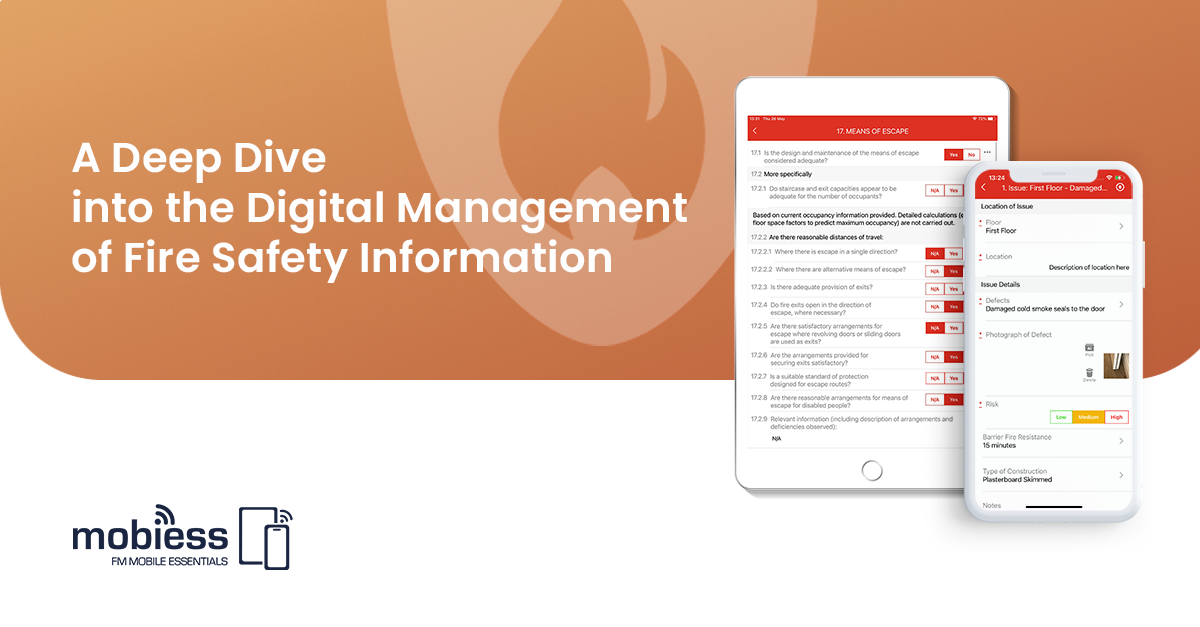A Deep Dive into the Digital Management of Fire Safety Information
When improperly managed, fire can be extremely hazardous. The rapid spread of flames and smoke has the potential to cause considerable damage to people, property, and the environment. To reduce the risk of fire, it is important to put in place the necessary fire prevention measures, install early warning systems, and devise an effective fire safety plan.
In the modern day, fire safety impacts our lives on a daily basis, whether we are at home or in the workplace. The UK’s first fire safety regulation was put in place after the Great Fire of London in 1666, aiming to protect the construction of buildings and roads from fire.
Unsurprisingly, fire safety has evolved significantly since then. In the last few decades, the world has become increasingly digital. As such, technological advancement has redefined the way in which fire safety is approached across the world.
In this article, we will explore everything you need to know about the digital revolution of fire safety, including the fundamental principles of fire safety, the role of specialised software in the field, and how technology can contribute towards the creation of safer environments.

The Key Principles of Fire Safety
There are a number of fire safety principles that individuals and teams should know about.
- Awareness: It is important for fire safety personnel and building occupants alike to be aware of the potential triggers that can result in unmanaged fires, including faulty wiring and flammable materials. Furthermore, they should know how to use a fire extinguisher.
- Prevention: It is essential to resolve any issues that have the potential to cause an unmanaged fire in a timely manner. It is also important to ensure that smoke detectors are in working order by regularly checking them.
- Preparedness: In any building, there must be an effective plan of action that occupants are to follow in the event of an emergency. Whether it is a residential or commercial building, a designated meeting point must be defined, and fire drills must be carried out. This ensures that building occupants are prepared to respond to a fire alarm by making a swift exit and attending the defined location.
The Role of Technology
In recent years, technology has truly transformed fire safety management, making it more powerful, efficient, and cost-effective than ever.
For example, with the integration of Internet of Things (IoT) sensors and smart devices, many modern fire systems monitor environmental conditions like temperature, smoke, and gas levels in real time, enabling them to swiftly detect abnormalities and trigger alarms. This empowers businesses and institutions to proactively identify potential fire risks and respond swiftly, leading to faster response times in the event of an emergency.
As well as this, technological advancement has led to the emergence of digital fire safety management software, which is designed to help organisations streamline their fire safety processes and inspections.
The Benefits of Using Digital Fire Safety Management Software
In comparison to traditional methods of fire safety management, digital fire safety management software solutions offer a multitude of advantages, including:
- Much simpler compliance documentation management, equipment maintenance scheduling and tracking, inspections, and emergency response coordination.
- The automation of tasks like scheduling inspections, creating reports, and tracking corrective actions. This streamlines time-consuming administrative processes.
- The centralisation and organisation of fire safety data into a single source, ensuring convenient access to all records, maintenance schedules, and inspection reports. This effectively reduces administrative costs and enhances compliance with safety regulations.
- Enhanced communication and coordination during emergencies, leading to significantly faster response times.
Overall, the comprehensive and automated nature of digital fire safety management software solutions makes them incredibly useful, not only for minimising fire-related risks but also for optimising resources and enhancing overall safety outcomes.
Who Should Adopt Digital Fire Safety Management Software?
The use of digital fire safety management software can benefit businesses across a wide range of industries.
Firstly, it can be an incredibly useful tool for the management of high-occupancy and public facilities like hotels, hospitals, educational institutions, retail centres, and infrastructure. With the safety of large numbers of people at stake, it is important to keep a thorough record of safety equipment like fire alarms and sprinkler systems in order to ensure that they are regularly inspected and properly maintained. This task can be simplified with the use of digital fire safety management software.
Furthermore, with digital fire safety management software, those responsible for overseeing large public facilities can maintain digital records of all compliance updates, streamlining their compliance with fire safety regulations. They can also ensure that regular fire drills are carried out.
Secondly, digital fire safety management software can be useful in the management of complex facilities like manufacturing plants, chemical processing plants, and large warehouses. In this type of environment, the fire safety requirements are likely to be elaborate, involving diverse fire suppression systems, hazardous materials, and specialised equipment. Usefully, digital fire safety management software can streamline the involved operations, simplify compliance tracking and maintenance, and enhance safety measures.
Implementing a Digital Fire Safety Management System
It is imperative that a digital fire safety management software solution is user-friendly and accessible to all stakeholders and building occupants. To accomplish this, safety managers and decision-makers must prioritise intuitive design, choosing a software solution with a clear, simple, and well-organised interface that can easily be navigated. As well as this, the solution they select should be inclusive to individuals with disabilities, adhering to accessibility standards like WCAG (Web Content Accessibility Guidelines).
Furthermore, safety managers and decision-makers should ensure that all employees receive comprehensive training sessions on how to use the chosen digital fire safety management software, including both in-person and online options to cater to their unique learning styles. In this, feedback and suggestions should be encouraged, fostering a sense of purpose and engagement amongst staff. Regular assessments should be conducted to identify areas where further training may be required. It could also be beneficial to create channels for user support, such as manuals, video tutorials, and a helpdesk.
The Challenges of Transitioning to a Digital Fire Safety Management System
In the process of transitioning to a digital fire safety management system, building safety teams are likely to encounter a range of organisational, technological, and cultural challenges, which they should be aware of and prepare for in advance.
Firstly, it is essential for organisations to meticulously plan for the expected costs of software procurement, hardware upgrades, and system maintenance.
Secondly, the integration of new software with existing systems may prove difficult, often requiring significant adjustment. Alongside this, challenges are likely to arise in data migration and system configuration. For this reason, it is highly important that large volumes of historical data are transferred whilst maintaining its integrity.
Thirdly, in terms of organisational culture, the introduction of a new digital fire safety management system may result in some resistance to change, particularly from those who have been in the industry for a long time and are comfortable with the traditional methods of fire safety management. To address this issue and ensure a smooth transition, effective change management strategies must be established.
Fourthly, fire safety teams must tackle the challenge of establishing clear processes for managing the new digital system. In this, responsibilities must be defined and distributed, which may require some restructuring.
Lastly, ensuring compliance with industry standards and regulations can be complex since it is necessary for digital systems to align with specific requirements. This adds another layer to the integration process.
These are all important factors for fire safety teams to consider before they begin the process of transitioning to a digital fire safety management software solution. With effective planning, they can successfully navigate these challenges and reap the benefits of digitalisation.
The Future of Fire Safety
Considering the impact technology has had on the management of fire safety thus far, it is no surprise that it is expected to play a pivotal role in shaping its future. It is interesting to note that, in 2023, the integration of IoT devices and sensors into fire safety systems appears to be an ever-growing trend. Such technologies are incredibly useful for speeding up response to fires and enhancing the accuracy of risk assessments.
On another note, the increased use of artificial intelligence (AI) and machine learning is expected to play a crucial role in fire safety management in the years to come, driving the advancement of predictive analytics. As a result, it is expected that the advancement of technology will make fire safety management more data-driven and proactive in the identification of fire hazards, leading to improved safety outcomes for building personnel and occupants alike.


